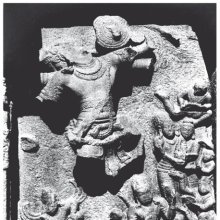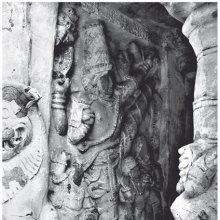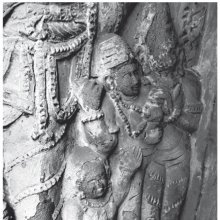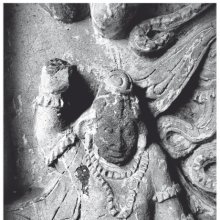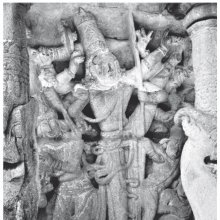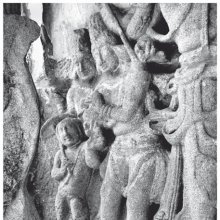Trivikrama, Tri-vikrama: 25 definitions
Introduction:
Trivikrama means something in Hinduism, Sanskrit, the history of ancient India. If you want to know the exact meaning, history, etymology or English translation of this term then check out the descriptions on this page. Add your comment or reference to a book if you want to contribute to this summary article.
Images (photo gallery)
(+12 more images available)
In Hinduism
Vaishnavism (Vaishava dharma)
Source: humindian: 108 names of Lord KrishnaOne of the 108 names of Krishna; Meaning: "Conqueror Of All The Three Worlds"
Source: Prabhupada Books: Sri Caitanya CaritamrtaTrivikrama (त्रिविक्रम).—According to Śrī Caitanya Caritāmṛta, Madya-lila 9.21-22, “At the holy place known as Skanda-kṣetra, Lord Śrī Caitanya Mahāprabhu visited the temple of Skanda. From there He went to Trimaṭha, where He saw the Viṣṇu Deity Trivikrama. After visiting the temple of Trivikrama, the Lord returned to Siddhavaṭa, where He again visited the house of the brāhmaṇa, who was now constantly chanting the Hare Kṛṣṇa mahā-mantra.”.

Vaishnava (वैष्णव, vaiṣṇava) or vaishnavism (vaiṣṇavism) represents a tradition of Hinduism worshipping Vishnu as the supreme Lord. Similar to the Shaktism and Shaivism traditions, Vaishnavism also developed as an individual movement, famous for its exposition of the dashavatara (‘ten avatars of Vishnu’).
Purana and Itihasa (epic history)
Source: archive.org: The Garuda puranamA Trivikrama stone bears the mark of a circle on the left side, that of a line on the right side and is of a dark-blue colour.
Source: archive.org: Puranic EncyclopediaTrivikrama (त्रिविक्रम).—Another name for Vāmana.
Source: Cologne Digital Sanskrit Dictionaries: The Purana IndexTrivikrama (त्रिविक्रम).—An avatār of Viṣṇu who conquered the three worlds with three steps; the lustrous God with sword as weapon;1 Mahātmyam of; in the vāmana purāṇa; icon of;2 Brahma-Puruṣottama.3
- 1) Brahmāṇḍa-purāṇa III. 3. 118; IV. 34. 79; Matsya-purāṇa 176. 59; Viṣṇu-purāṇa V. 5. 17.
- 2) Matsya-purāṇa 53. 45; 260. 36.
- 3) Vāyu-purāṇa 108. 38.

The Purana (पुराण, purāṇas) refers to Sanskrit literature preserving ancient India’s vast cultural history, including historical legends, religious ceremonies, various arts and sciences. The eighteen mahapuranas total over 400,000 shlokas (metrical couplets) and date to at least several centuries BCE.
Pancaratra (worship of Nārāyaṇa)
Source: Wisdom Library: PāñcarātraTrivikrama (त्रिविक्रम, “He who pervades the 3 Vedas”):—One of the twenty-four forms of Viṣṇu through which Nārāyaṇa manifests himself. He is accompanied by a counterpart emanation of Lakṣmī (an aspect of Devī) who goes by the name Kriyā.
Source: archive.org: Isvara Samhita Vol 1Trivikrama (त्रिविक्रम) refers to one of the various Vibhava manifestations according to the Īśvarasaṃhitā 24.316b-319.—Accordingly, “Bhagavān who is Ananta and who is present in the waking and other state, controls those who have the brilliance of the sun, moon and fire, stays with the glory of sentience of the fourth stage (transcendental). He prompts out of His own liking, the power which has the brilliance (like) nectar arising from His feet and which causes delight to those who do their work and are devoted to Him, who fill the three worlds, is of a yellowish complexion, shining (having) groups of arms possessing various mudrās and weapons, who destroys enemies bearing ākaśagaṅgā with the stiff foot reaching the sky and a flag for (the sake of) Gods who requested for victory, sword, discus, mace, club, arrows, goad (with) and hammer, lance, axe, and a fire slab in His ten dexter hands and conch, javelin, bow (called Śārṅga), snare, trident, plant, thunderbolt, knife plough, big pestle in the left hands are to be meditated upon. Other ten hands with mudrās are marked by (conveying) the fear wonder taking mud, and seizing (a person) by the (braid of) hair and clasping are the five mudrās of the Lord to be meditated upon in the five (left) hands and those offering the boon with the name prosperity, bringing things together, offering security and preservation of the same number in the right hands”.
These Vibhavas (e.g., Trivikrama) represent the third of the five-fold manifestation of the Supreme Consciousness the Pāñcarātrins believe in. Note: The name Trivikrama is given to Vāmana who grew up and took three strides (krama). Parāśarabhaṭṭa Viṣṇusahasranāma vyākhyā on Name 533. gives a different interpreation by quoting a passage the source of which is not known. This means that Viṣṇu had passed through all the three Vedas or had gone beyond them. The root kram means to walk over, cross over. The word Vikrama cannot therefore mean studying the three Vedas but has gone beyond them, prominent in them.

Pancaratra (पाञ्चरात्र, pāñcarātra) represents a tradition of Hinduism where Narayana is revered and worshipped. Closeley related to Vaishnavism, the Pancaratra literature includes various Agamas and tantras incorporating many Vaishnava philosophies.
Shilpashastra (iconography)
Source: archive.org: Pratima Kosa Encyclopedia of Indian Iconography - Vol 6Trivikrama (त्रिविक्रम) refers to one of the many varieties of the Śālagrāma (ammonite fossil stones).—The Trivikrama is black in colour (śyāma); two cakras on the left side (vāma-cakra) and two cakras on the right (dakṣa-cakra); line suggesting vanamālā; according to another account, a cakra on the left side and line on the right (dakṣa-rekhā); rightward inclination (dakṣiṇāvarta). Śālagrāma stones are very ancient geological specimens, rendered rounded and smooth by water-currents in a great length of time. They (e.g., Trivikrama stones) are distinguished by the ammonite (śālā, described as “vajra-kīṭa”, “adamantine worms”) which having entered into them for residence, are fossilized in course of time, leaving discus-like marks inside the stone.
Source: Archaeological Survey of India: Śaiva monuments at Paṭṭadakal (śilpa)Trivikrama (त्रिविक्रम) is also found as a sculpture on the ninth pillar of the southern half of the maṇḍapa of the temple of Trailokyeśvara.—At the lower portion of the pillar is sculptured Viṣṇu, Trivikrama. The God asking Bali to donate him three feet of land is the theme of this image. Viṣṇu is standing with one foot on the earth and the other in the sky. To the right is the chain of human figures, carved one below the other. At the bottom of the tableau is an unfinished image, probably of Garuḍa. The swings and sways of this figure of Viṣṇu Trivikrama remind us the dancing figure of Śiva on the pillar nearby. We think probably the same artist must have carved this representation too.
Source: academia.edu: Dvādaśa-mūrti in Tamil Tradition (iconography)Trivikrama (त्रिविक्रम) refers to one of the Dvādaśa-mūrti or “twelve sacred names of Viṣṇu”, whose iconographical details are mentioned in the Śrītattvanidhi (verse 2.19-42) citing the Pāñcarātrāgama-Kriyapāda.—Trivikrama’s colour is red and fitted with kirīṭa, hāra, keyūra, kuṇḍalas and other ornaments. According to the Caturviṃśatimūrtilakṣaṇa, Trivikrama is fitted with the Śaṅkha, Cakra, Gāda and Padma, in that particular order.

Shilpashastra (शिल्पशास्त्र, śilpaśāstra) represents the ancient Indian science (shastra) of creative arts (shilpa) such as sculpture, iconography and painting. Closely related to Vastushastra (architecture), they often share the same literature.
Vyakarana (Sanskrit grammar)
Source: Wikisource: A dictionary of Sanskrit grammarTrivikrama (त्रिविक्रम).—Pupil of Vardhamana who wrote a gloss called ’पञ्जिकोद्द्योत (pañjikoddyota)’. on the Katantra-vrtti

Vyakarana (व्याकरण, vyākaraṇa) refers to Sanskrit grammar and represents one of the six additional sciences (vedanga) to be studied along with the Vedas. Vyakarana concerns itself with the rules of Sanskrit grammar and linguistic analysis in order to establish the correct context of words and sentences.
Ayurveda (science of life)
Rasashastra (Alchemy and Herbo-Mineral preparations)
Source: Wisdom Library: Rasa-śāstraTrivikrama (त्रिविक्रम) or Trivikramarasa is the name of a Ayurvedic recipe defined in the fifth volume of the Rasajalanidhi (chapter 11, Gulma: tumour in the belly). These remedies are classified as Iatrochemistry and form part of the ancient Indian science known as Rasaśāstra (medical alchemy). However, since it is an ayurveda treatment it should be taken with caution and in accordance with rules laid down in the texts.
Accordingly, when using such recipes (e.g., trivikrama-rasa): “the minerals (uparasa), poisons (viṣa), and other drugs (except herbs), referred to as ingredients of medicines, are to be duly purified and incinerated, as the case may be, in accordance with the processes laid out in the texts.” (see introduction to Iatro chemical medicines)

Āyurveda (आयुर्वेद, ayurveda) is a branch of Indian science dealing with medicine, herbalism, taxology, anatomy, surgery, alchemy and related topics. Traditional practice of Āyurveda in ancient India dates back to at least the first millenium BC. Literature is commonly written in Sanskrit using various poetic metres.
General definition (in Hinduism)
Source: Shodhganga: Historical setting of the vaisnava divyaksetras in the southern pandya countryTrivikrama (त्रिविक्रम) is the elongated version of Vāmana, the Dwarf;
India history and geography
Source: What is India: Inscriptions of the ŚilāhārasTrivikrama (fl. 1137 A.D.) is mentioned in the “Vaḍavalī grant of Aparāditya I”. Accordingly, “... by pouring water with great devotion, to the sacrificing priest Trivikrama, the son of the Agnihotrin Ananta of the Vārṣeyagaṇa-gotra and the Vāji-Mādhyandina-śākhā, who is a distinguished Brāhmaṇa engaged in the performance of the six duties such as sacrificing for oneself and others, studying and teaching (of the sacred texts) and so forth”.
These copper plates (mentioning Trivikrama) were in the possession of a blacksmith at Vaḍavalī near Ṭhāṇā. Its object is to record the grant, by Aparāditya, of the village Vaḍavalī in the Karakūṭa-viṣaya and also of a field in the village Mora in the Vareṭikā-viṣaya. It is dated on the fifteenth tithi of the bright fortnight of Kārttika in the Śaka year 1049, the cyclic year being Plavaṅga.

The history of India traces the identification of countries, villages, towns and other regions of India, as well as mythology, zoology, royal dynasties, rulers, tribes, local festivities and traditions and regional languages. Ancient India enjoyed religious freedom and encourages the path of Dharma, a concept common to Buddhism, Hinduism, and Jainism.
Languages of India and abroad
Sanskrit dictionary
Source: DDSA: The practical Sanskrit-English dictionaryTrivikrama (त्रिविक्रम).—Viṣṇu in his fifth or dwarf incarnation. °रसः (rasaḥ) a patent medicine in Āyurveda.
Derivable forms: trivikramaḥ (त्रिविक्रमः).
Trivikrama is a Sanskrit compound consisting of the terms tri and vikrama (विक्रम).
Source: Cologne Digital Sanskrit Dictionaries: Shabda-Sagara Sanskrit-English DictionaryTrivikrama (त्रिविक्रम).—m.
(-maḥ) A name of Vishnu. E. tri, and vikrama going; crossing over the three worlds in three steps, to the discomfiture of Bali.
Source: Cologne Digital Sanskrit Dictionaries: Benfey Sanskrit-English DictionaryTrivikrama (त्रिविक्रम).—I. n. three steps, [Rāmāyaṇa] 6, 79, 11. Ii. adj. and sbst. walking with three steps over the heaven, epithet of Viṣṇu (as sun), [Rāmāyaṇa] 1, 32, 13 Gorr.
Trivikrama is a Sanskrit compound consisting of the terms tri and vikrama (विक्रम).
Source: Cologne Digital Sanskrit Dictionaries: Cappeller Sanskrit-English DictionaryTrivikrama (त्रिविक्रम).—[neuter] the three steps; [masculine] [Epithet] of Viṣṇu.
Source: Cologne Digital Sanskrit Dictionaries: Aufrecht Catalogus Catalogorum1) Trivikrama (त्रिविक्रम) as mentioned in Aufrecht’s Catalogus Catalogorum:—son of Makarandapāla, father of Dehṛṇapāla, grandfather of Apipāla (Śūdrapaddhati). L. 1980.
2) Trivikrama (त्रिविक्रम):—See Vaidyatrivikrama.
3) Trivikrama (त्रिविक्रम):—lawyer. Quoted in Nirṇayasindhu and Pratiṣṭhāmayūkha. See Traivikramī.
4) Trivikrama (त्रिविक्रम):—lexicographer. Quoted by Hemādri and Dinakara on Raghuvaṃśa.
5) Trivikrama (त्रिविक्रम):—astronomer. Quoted by Mahādeva Oxf. 336^a, by Viśvanātha Oxf. 338^a.
6) Trivikrama (त्रिविक्रम):—Kālavidhāna jy.
7) Trivikrama (त्रिविक्रम):—Tithisāriṇī jy. Bṛhmaṇa (?) jy. Brahmavyavahāra jy. Śataślokavyavahāraka or Trivikramaśataka jy. Strījātaka. Bik. 339.
8) Trivikrama (त्रिविक्रम):—Pañjikoddyota. Kh. Vi.
9) Trivikrama (त्रिविक्रम):—Madālasacampū. Report. Xi.
10) Trivikrama (त्रिविक्रम):—Rāmakīrtimukundamālā. Oudh. Ix, 18. Peters. 3, 396 (Rāmakīrtikumudāvali).
11) Trivikrama (त्रिविक्रम):—Kuvalayāśvavilāsa campū.
12) Trivikrama (त्रिविक्रम):—Nyāsapaddhati [dharma]
13) Trivikrama (त्रिविक्रम):—the author of the Vāyustuti, wrote also a Tattvapradīpikā q. v.
14) Trivikrama (त्रिविक्रम):—Vyājoktiśataka.
15) Trivikrama (त्रिविक्रम):—son of Mahādeva: Siddhāntatattva jy.
16) Trivikrama (त्रिविक्रम):—a pupil of Vardhamāna: Kātantravṛttipañjikoddyota.
17) Trivikrama (त्रिविक्रम):—the author of the Prākṛtānuśāsana, is quoted by Appayya Dīkṣita in his Prākṛtamaṇidīpikā.
18) Trivikrama (त्रिविक्रम):—son of Raghu Sūri, grandson of Sāraṅga Sūri: Vṛttaratnākaraṭīkā. Peters. 5 p. 26. He mentions his C. on Durga's Kātantravṛtti and his Bṛhadvṛtti on the Sarasvatīsūtra.
Source: Cologne Digital Sanskrit Dictionaries: Monier-Williams Sanskrit-English Dictionary1) Trivikrama (त्रिविक्रम):—[=tri-vikrama] [from tri] n. the 3 steps (of Viṣṇu), [Rāmāyaṇa vi; Kumāra-sambhava] (in [compound])
2) [v.s. ...] mfn. or m. who strided over the 3 worlds in 3 steps (Viṣṇu), [Harivaṃśa 2641; Rāmāyaṇa i etc.]
3) [v.s. ...] m. Name of a Brāhman, [Śukasaptati]
4) [v.s. ...] of the author of a work (called after him Traivikramī), [Nirṇayasindhu iii]
5) [v.s. ...] of a medical author and of a mixture (called after him), [Rasendracintāmaṇi]
6) [v.s. ...] = -bhaṭṭa
Source: Cologne Digital Sanskrit Dictionaries: Yates Sanskrit-English DictionaryTrivikrama (त्रिविक्रम):—[tri-vikrama] (maḥ) 1. m. A name of Vishnu.
Source: DDSA: Paia-sadda-mahannavo; a comprehensive Prakrit Hindi dictionary (S)Trivikrama (त्रिविक्रम) in the Sanskrit language is related to the Prakrit word: Tivikkama.
[Sanskrit to German]
Sanskrit, also spelled संस्कृतम् (saṃskṛtam), is an ancient language of India commonly seen as the grandmother of the Indo-European language family (even English!). Closely allied with Prakrit and Pali, Sanskrit is more exhaustive in both grammar and terms and has the most extensive collection of literature in the world, greatly surpassing its sister-languages Greek and Latin.
Kannada-English dictionary
Source: Alar: Kannada-English corpusTrivikrama (ತ್ರಿವಿಕ್ರಮ):—[noun] one of the forms of Viṣṇu, in which he pervaded the earth, lower region and the heaven, each by a gigantic step.
Kannada is a Dravidian language (as opposed to the Indo-European language family) mainly spoken in the southwestern region of India.
See also (Relevant definitions)
Partial matches: Tri, Vikrama.
Starts with (+2): Trivikrama acarya, Trivikrama bhatta, Trivikrama pandita, Trivikrama panditacarya, Trivikrama suri, Trivikramabhatta, Trivikramacarita, Trivikramacarya, Trivikramadeva, Trivikramadeva gaudantahpuravaidya, Trivikramajna bhattaraka, Trivikramaka, Trivikramananda, Trivikramanandanatha, Trivikramanarayana, Trivikramapanditasunu, Trivikramarasa, Trivikramasana, Trivikramasena, Trivikramashataka.
Ends with: Bhagavata trivikrama, Vaidyatrivikrama.
Full-text (+101): Traivikrama, Traivikrami, Trivikramabhatta, Makarandapala, Trivikramasena, Trivikramadeva, Trivikramatirtha, Nemaditya, Tirivikkiraman, Trivikramasana, Vaidyatrivikrama, Trivikramacarya, Trivikrama acarya, Tiri-vikkiramaracam, Trivikrama pandita, Trivikrama panditacarya, Lalla, Pancayudhaprapanca, Brahmavyavahara, Trivikrama bhatta.
Relevant text
Search found 62 books and stories containing Trivikrama, Tri-vikrama; (plurals include: Trivikramas, vikramas). You can also click to the full overview containing English textual excerpts. Below are direct links for the most relevant articles:
Srila Gurudeva (The Supreme Treasure) (by Swami Bhaktivedanta Madhava Maharaja)
Weeping like a Village Girl < [Chapter 2.14 - Lessons on Service and Absorption]
Śrī Śrīmad Bhaktivedānta Trivikrama Gosvāmī Mahārāja < [Chapter 1.6 - Return to Maṭha Life]
Serving the Society–Serving the Devotees < [Chapter 1.2 - Śrīla Gurudeva’s Pūrvāśrama]
Garga Samhita (English) (by Danavir Goswami)
Verse 1.2.30 < [Chapter 2 - Description of the Abode of Śrī Goloka]
Verse 2.25.22 < [Chapter 25 - The Rāsa-dance Pastime]
Dvisahasri of Tembesvami (Summary and Study) (by Upadhyay Mihirkumar Sudhirbhai)
Chapter 13 - Staying at the confluence of rivers Bhīmā and Amarajā
Chapter 15 - Fruition of Action
Chaitanya Bhagavata (by Bhumipati Dāsa)
Verse 1.15.8 < [Chapter 15 - Marriage with Śrī Viṣṇupriyā]
Verse 1.13.141 < [Chapter 13 - Defeating Digvijayī]
Verse 1.8.15 < [Chapter 8 - The Disappearance of Jagannātha Miśra]
Vasudevavijaya of Vasudeva (Study) (by Sajitha. A)
Śrīcihnakāvya of Kṛṣṇalīlāśuka and Durgāprasādayati < [Chapter 1 - Śāstrakāvyas—A Brief Survey]
Tiruvaymoli (Thiruvaimozhi): English translation (by S. Satyamurthi Ayyangar)
Pasuram 3.3.11 < [Section 3 - Third Tiruvaymoli (Olivu il kalam)]
Pasuram 2.2.3 < [Section 2 - Second Tiruvaymoli (Tinnan vitu)]
Pasuram 4.3.7 < [Section 3 - Third Tiruvaymoli (Kovai Vayal)]
Related products
